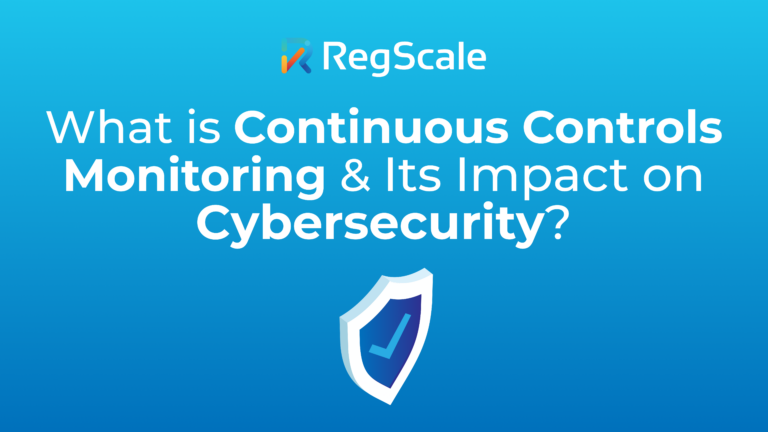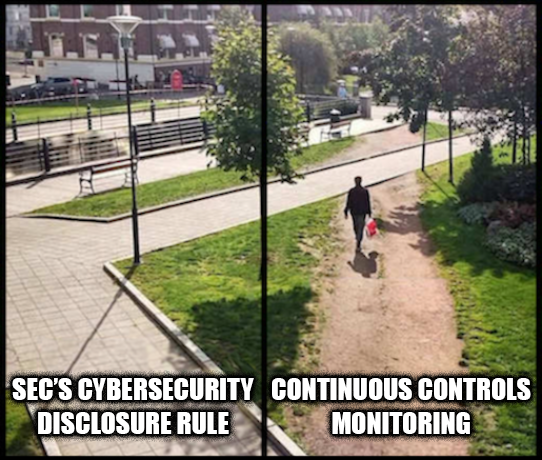What is Continuous Controls Monitoring & Its Impact on Cybersecurity?

It’s 2024 and the rules have changed, literally. Late in 2023, the U.S. Securities and Exchange Commission (SEC) issued new requirements for cybersecurity disclosures. In addition to reporting material cybersecurity incidents within four days, now all public companies will be required to file annual reports—documenting their cybersecurity risk management, strategy, and governance.
This has put many security professionals in a panic. They can imagine the months-long workload of documenting security controls by the end of their fiscal year. Don’t even mention having to measure “material” impact, strategize remediation, and pull disclosures together within hours of a major incident.
If only there were a way—like through some sort of continuous monitoring solution—that cybersecurity folks could gain real-time visibility into their readiness posture and generate reports on that. “If only!”
Enter CCM: Continuous Controls Monitoring
As defined by a leading analyst firm, “CCM is a set of technologies to reduce business losses through continuous monitoring and reducing the cost of audits through continuous auditing of the controls in financial and other transactional applications.”
CCM has revolutionized governance, risk & compliance (GRC) by streamlining audits and outcomes, providing real-time assessment, analysis, and reporting about the status of the organization’s security controls. CCM is the “secret sauce” that reduces audit fatigue and saves practitioners weeks (even months) of time preparing for such demanding compliance programs as:
- Federal Risk and Authorization Management Program (FedRAMP)
- International Organization for Standardization (ISO)
- System and Organization Controls (SOC 2), and
- Other business-critical certifications
What’s even more exciting—especially to companies now living under the pressure of the SEC cybersecurity rule—is how CCM can not only make compliance with disclosure mandates easier than you imagined but can greatly optimize your organization’s cybersecurity posture by providing more complete and transparent risk assessments.

What CCM means for compliance and security
The lessons learned from CCM about simplifying ongoing risk management and reporting could fill a book—or at least a white paper. As it happens, Dr. Edward Amoroso, CEO of TAG Cyber, recently released a comprehensive white paper on how this methodology intersects with cybersecurity: Leveraging Continuous Controls Monitoring (CCM) for Compliance and Security.
This white paper provides a detailed introduction and overview of CCM from the perspective of today’s enterprise security and compliance practitioners.
Compliance and security practitioners share a common complaint. They say that their biggest challenge involves finding effective ways to reduce the time, drudgery, and cost associated with their present and future compliance projects and initiatives. That’s exactly where CCM comes to the rescue.
1. It’s time to get real-time
As its name implies, continuous controls monitoring uses technology to proactively manage and monitor IT risks and compliance issues in near real-time. A platform offered as a managed service, CCM enables organizations to operate without interruption—while retaining transparency and an always-current audit trail.
Through seamless integrations, this continuous monitoring technology can complement existing GRC or create new GRC coverage. This integration enables simultaneous visibility into all layers related to compliance and security—for both legacy and future tools deployed in the enterprise.
This integration also eliminates redundancies (and associated costs) during the assessment and evidence collection.
2. Actively reduce risk instead of reacting to it
Traditional, fragmented, reactive methods of handling IT risks and compliance are no longer sufficient. DevOps, Agile enterprise management, and cybersecurity technologies (including cyber threats) are evolving at an increasingly rapid pace. This constant state of change demands a proactive approach to ensure uninterrupted enterprise risk management. CCM provides that non-stop capability.
This continuity is important for deploying critical infrastructure, including government environments driven by standards such as FedRAMP, NIST, SOC2, or other frameworks.
The best CCM platforms—like RegScale—enable real-time data monitoring and continuous surveillance of IT systems. Beyond surveillance, an effective CCM platform drives proactive compliance management by collecting not just present-state data about controls, but also enables real-time updates, automated reporting, and resource optimization.
CCM empowers decision-makers
By providing real-time data at their fingertips, CCM assists more than compliance practitioners with preparations for audits and critical business certifications. It also arms CISOs and other executives with meaningful, accurate visualizations and the information they need for better judgment calls—whether in routine operations or crisis scenarios.
This overarching awareness CCM provides enables organizations to remain adaptive and resilient in their IT risk strategies. The benefit of this ongoing visibility into controls goes both ways. Better risk assessments harden enterprises against known vulnerabilities, and when IT architectures remain provably resilient to cybersecurity issues, compliance flows naturally.
Ready to get started?
Choose the path that is right for you!
Skip the line
My organization doesn’t have GRC tools yet and I am ready to start automating my compliance with continuous monitoring pipelines now.
Supercharge
My organization already has legacy compliance software, but I want to automate many of the manual processes that feed it.